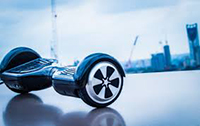 Marty McFly rode a hoverboard in the 1989 move “Back to the Future II”, and today’s version was one of the hottest gifts of 2015. If you received one or know someone who did, learn more about insuring your new toy.
Marty McFly rode a hoverboard in the 1989 move “Back to the Future II”, and today’s version was one of the hottest gifts of 2015. If you received one or know someone who did, learn more about insuring your new toy.
What is a Hoverboard?
Basically, a hoverboard is a battery-powered skateboard without wheels. To operate it, you place it on the ground, stand on it and use your body’s balance to propel yourself around your driveway, down the sidewalk or around town. Balancing can be tricky until you get the hang of moving forward, backward or to either side.
The hoverboard is small enough to place in a duffle bag or locker and weighs only 20-25 pounds. It’s made from a metal alloy and features an anti-slip foot grip. Some models support up to 200 pounds and can go up to 15 miles per hour. Certain models hold a charge that lasts 10 hours and allows you to ride for miles. You can purchase the toy for $200 to $2000.
Hoverboard Safety Risks
Despite their popularity, hoverboards have faced criticism over their safety.
Batteries
The very batteries that give the hoverboard its power can also overheat. Some have been known to catch on fire after being ridden short distances and others have ignited while being charged.
Obstacles
You need to navigate sidewalk cracks, bumps and other obstacles to remain on your hoverboard. Watch out for other people, too, because you don’t want to lose control and collide with anyone.
Balance
Riders need a strong core and abdominal muscles to handle their hoverboard successfully. Without these two physical traits, you’ll lose your balance and could suffer from a concussion or break your elbow, wrist, tailbone or ankle.
Riding Tips
Stay safe on your hoverboard when you:
- Know where you can ride them. Many cities, colleges, stadiums and other public places have banned hoverboards.
- Wear a helmet and knee pads.
- Do exercises that strengthen your core and abdominal muscles.
- Practice balancing on flat surfaces and take short rides before trying to master uneven terrain or longer treks.
- Stay with your hoverboard as it charges.
- Supervise kids and make sure they can and do ride safely.
Insuring a Hoverboard
Your insurance agent will assist you in insuring your hoverboard under your homeowner’s or renter’s policy. If your hoverboard malfunctions, contact your agent. He or she will want to record any evidence and assess the damage before you toss the toy or clean up the mess.





